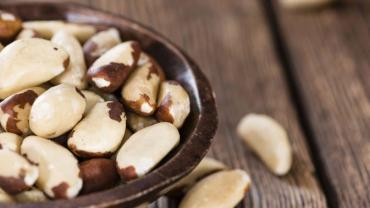
Now that dietary fat is no longer public enemy #1 healthy high-fat foods are reclaiming their rightful and delicious place in people’s meals. For starters Time magazine publicized the exoneration of butter not long ago and then there’s coconut which is rich in health-promoting medium-chain triglycerides and fatty fish rich in DHA. No one needs to feel guilty for indulging in fat-heavy guacamole and let’s not forget nuts.
A hefty body of research indicates that nut consumption is associated with good cardiovascular health possibly owing to their complement of vitamins minerals and healthy fats. An ounce or two of mixed nuts makes for a great snack but in a container of almonds pistachios walnuts pecans peanuts and cashews it seems like one nut in particular tends to get left behind and that’s Brazil nuts. All the rest are carefully selected until all that’s left lingering at the bottom are those large oblong Brazils.
Why should this be the case? When it comes to nutrient content Brazil nuts need not play second fiddle to any other specimen. These morsels are rich in magnesium phosphorus copper and manganese. They’re not quite as high in vitamins providing appreciable amounts of only two—thiamin and vitamin E but overall they’re a good source of antioxidants. Brazil nuts are probably best known for selenium and for good reason: a one-ounce serving packs 767% percent of the daily value for this mineral. (As is true for any other mineral though the content will vary depending on soil conditions.)
Brazil nuts’ generous selenium content may be good for individuals with decreased conversion of T4 to T3 as this enzymatic reaction requires selenium. In a study of 40 patients on hemodialysis all of whom were selenium deficient supplementation with just one Brazil nut per day for three months resulted in significant increases in plasma selenium T3 and free T4. Selenium is also key for maintaining glutathione status; hypertensive and dyslipidemic subjects supplemented with 13 grams of partially defatted granulated Brazil nuts daily for twelve weeks experienced significant increases in plasma selenium and glutathione peroxidase activity with decreases in oxidized LDL.
Like all nuts and seeds Brazil nuts are high in fat but the types of fat that predominate put these squarely in the camp of “good fats.” One ounce of Brazil nuts provides about 19 grams of fat of which 7 grams are monounsaturated (mostly oleic acid) 4.2 grams are saturated (mostly palmitic and stearic acids) and 5.8 grams are polyunsaturated. Of the polyunsaturated portion it’s almost entirely omega-6 (5.7 grams) with an extremely scant 5 milligrams of omega-3. Yes this is over a thousand-to-one ratio but considering the total amount of omega-6 is less than 6 grams this shouldn’t be a deal-breaker for those concerned about their omega-6 intake. A reasonable portion of nuts (for those who are able to restrain themselves!) will not tip the n-6/n-3 balance into dangerous territory. This is a bigger concern when talking about more highly concentrated sources of omega-6 such as corn soybean or cottonseed oils.
Brazil nuts stand alongside macadamias as a great go-to for low-carbers and those who follow ketogenic diets. The high fat content is coupled with an extremely low amount of carbohydrate—just one net gram in a one-ounce serving (3 grams total minus 2 grams of fiber).
The main drawback to eating Brazil nuts is that they’re difficult to shell. Buying nuts already shelled is an easy way around this but nuts in the shell tend to be easier on the ol’ wallet. (Plus if you have to shell them you’re less likely to overeat them which is all too easy when you can grab a handful of shelled nuts right out of the container.) The shell may crack pretty easily but it also sticks to the nut making it an exercise in frustration to separate them. A handy trick is to store Brazil nuts in the fridge or freezer; having the nuts cold seems to make shelling much easier. (Keeping them cold will also prolong their shelf life as it will protect the fatty acids from becoming rancid.)
As for getting some Brazil nuts into your diet there are sweet and savory ways to incorporate these tasty bits into meals and snacks. How about a completely sugar-free Brazil nut brittle? (Add stevia xylitol or erythritol if you prefer it on the sweet side or simply use 85% cocoa instead of 100%.) Or try these coconut and Brazil nut truffles for a sweet treat that will wow guests’ eyes and please their palates. For a snack on the savory side add Brazil nuts to this recipe for spiced nuts featuring a blend of herbs and spices or try your hand at a unique Paleo-friendly bean-free hummus made with cauliflower daikon radish and Brazil nuts. For those with a dairy sensitivity who still want to enjoy a cold creamy beverage or have something to put in their coffee or use in baking recipes there’s homemade Brazil nut milk.